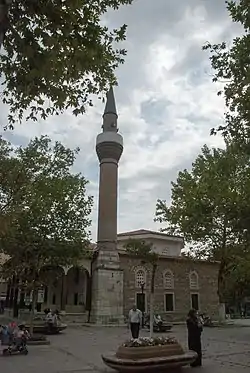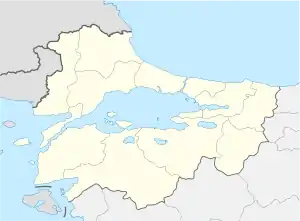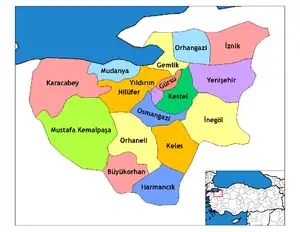Yenişehir, Bursa
Yenişehir is a district of Bursa province. It is 52 km far from the east of Bursa and Bursa city center. Bursa's international airport is within the borders of Yenişehir. For this reason, the Airport is called 'Yenişehir Airport'.
Yenişehir | |
|---|---|
 | |
 Yenişehir Location of Yenişehir within the Region of Marmara  Yenişehir Location of Yenişehir within Turkey | |
| Coordinates: 40°15′52″N 29°39′11″E | |
| Country | |
| Province | Bursa |
| Area | |
| • District | 786 km2 (303 sq mi) |
| Population (2012)[2] | |
| • Urban | 31,643 |
| • District | 51,837 |
| • District density | 66/km2 (170/sq mi) |
County economics is agricultural and livestock based. Although founded by the municipality in 2004, the YOIZ (Yenişehir Organized Industrial Zone) began the industrialization boom. It is the number one district of Bursa, especially in the export of agricultural products. Tomato and pepper cultivation is world famous.
The region has a mild Marmara climate.
It is located close to İnegöl and İznik. Some of the people of Yenişehir go to Bursa and İnegöl to work. Yenişehir is neighbor to Kestel in the west, İnegöl in the south, İznik in the north, Orhangazi in the north-west and Bilecik in the east. The total population of the district is around 52,200.
History
Yenişehir, which was established by building permanent houses for the first time from the tent life in the Beylik period of the Ottoman Empire, was used by the Ottoman Army in Anatolia and Middle East expeditions due to its wetland and wide plain. The city was founded by Osman Gazi,where for the first time, a sermon was read, coins were printed, taxes were collected, a regular army was started to be established, and the first law (edict) was commanded here. Then the city was the capital for a short time (29 years) (although Söğüt is also claimed to be the capital) and the city handed over the duty as capital with the acquisition of Bursa. The district is one of the developing districts of Bursa province.
The known history of Yenişehir dates back to the beginning of the 14th century. It was connected to the Ertuğrul sanjak, where Bilecik was the center at that time, and continued this position until 1926. İznik was the subdistrict of the city between 1926 and 1930.
After the capture of Köprühisar and Yarhisar in the years when the Ottoman Empire became a state, Osman Bey gave this region to his veterans as a sword right. Yenişehir became known with this name for the first time since it was opened for construction. In the book "Ottoman History", written by İsmail Hakkı Uzunçarşılı, the phrase "A Turkish city was established in the plain and a headquarters was built because it was close to the battlefield".
In the light of this information, it is understood that Yenişehir was established as a Turkish city and opened to residence. Yenişehir, a 680-year-old Turkish city, was occupied by the Greeks during the Turkish War of Independence/Greco-Turkish War between October 27, 1920 and September 6, 1922, and on September 6, 1922, the city was liberated from the occupation. The establishment of the villages goes back to old times, for example, the Yarhisar neighborhood is known to have Tekfur barracks during the Byzantine period. Likewise, Akbıyık and Süleymaniye villages have remained from the Byzantine period (castle). The Ottomans built many historical monuments in the city. 10 of the 17 mosques in the district center belong to the Ottoman period. Some of the mosques and baths built in villages were built during the Ottoman period. Other historical monuments in the district are Babasultan Lodge, Sinanpaşa Mosque and Caravansary, Çiftehamamlar, Süleymanpaşa Mosque and Mausoleum, Palace Bath, Shemaki House.
While describing the history of Yenişehir, it made it easier to tell that Osman Ghazi, the founder of the Ottoman Empire, spent his childhood in the Yarhisar neighborhood, and won great victories against the Byzantines in the Koyunhisar plain. The Ottomans also went to the west in several wars. In these wars, Osman Bey's brother Aydoğdu Bey was martyred. His grave is still in Koyunhisar neighborhood.
Culture and tourism
The district, which is located 52 km east of Bursa and joined the Ottoman territory in the period of Osman Gazi, was granted to the veterans by Osman Gazi under the name of sword right. The city, which was established at the location opened to living, was named Yenişehir.
It has rich historical artifacts from the Ottoman period. The Palace Bath, which was left behind from the palace built by Osman Gazi in Yenişehir, is the Postinpuş Baba Lodge from the period of Murad I. Voyvoda Mosque (Çınarlı Mosque), built in the 14th century, Koca Sinan Pasha Complex, Bali Bey Mosque, built in the 16th century. Ulu Mosque, Süleyman Pasha Complex, built by Orhan Bey, Double Bath, built by Hüseyin Pasha of Yenişehir in 1645, Yarhisar Village Orhan Mosque and Clock Tower are historical buildings worth seeing. In addition, there are historical tumuluses in Barcın Neighborhood of Yenişehir.
Economic structure
The main income source of the district is agriculture. 78.7% of the total population lives on agriculture. All villages provide their livelihood with agricultural production, and 10,789 people of the district center's population also provide their livelihood with agricultural production. Industrialization in the district, where agriculture can be made in approximately 65% of its land, has started to develop. In 2004 and in the total area of 173.5 hectares in the Organized Industrial Zone, by Turkey Glass Bottle Factories, Anatolia Glass Yenişehir Inc. and Thrace Glass Yenişehir Inc., two factories operating in the field of glass packaging and flat glass were established. The total number of workers working in both factories is 1,064.
In addition, there are 2 vegetable oil factories, 3 flour factories, 1 dairy factory, 3 dairy workshops and 1 auto spare parts mold production factory. 343 people are employed in these facilities.
Yenişehir Shemaki House Museum
It was built in the 18th century by the Shemaki family who came to Anatolia from Shemakh town of Iran and settled in Yenişehir. On the ground floor of the two-story house there is a stony kitchen and a cellar to the right and two winter rooms to the left.
You can go upstairs with wooden stairs adjacent to the kitchen wall. Facing the garden, the front facade opens to the outside with arched sections in the form of porticoes. There is a big room opening to the sofa with iwan on the left and two rooms, one on the right and one on the small. Pen works with ornamental motifs and landscape decorations adorning the house from the 19th century.
There is no bathhouse part that is said to be located in the garden today.
Yenişehir Shemaki House Museum is open to visitors every day except Monday.
Transportation
Road transport
Yenişehir is 25 km from İznik district in the north, 27 km from İnegöl district in the south, 45 km from Bilecik province in the east and 52 km from Bursa province in the west. There are scheduled bus services to Yenişehir from all four cities.
Airline transportation
At Bursa Yenişehir Airport, scheduled civil flight services and cargo transportation can be made.
Media
Visual media service was provided for a period under the name of Yenişehir TV (Yörem TV). There was also a radio publishing house broadcasting on the FM band called Radio Sırdaş locally. Today, there is no active radio and television channel in the district. Representations of national and regional news agencies and media organizations are located in the district.
- Local newspapers
- Detay Newspaper (Weekly)
- Gündem Newspaper (6 days a week)
- Harman Newspaper (2 days a week)
- Yörem Newspaper (7 days a week)
- Alternatif Newspaper (7 days a week)
Civil society organizations
Some non-governmental organizations operating in the district are:
References
- "İl ve İlçe Yüzölçümleri" [Provincial and District surface area] (PDF) (in Turkish). Harita Genel Komutanlığı. Retrieved 2013-02-28.
- "Population of province/district centers and towns/villages by districts - 2012". Address Based Population Registration System (ABPRS) Database. Turkish Statistical Institute. Retrieved 2013-02-27.
